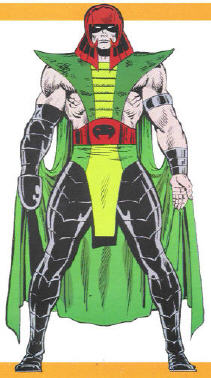
SETH

Real Name: Unrevealed, allegedly Seth, possibly Suty or Sutekh
Identity/Class: Heliopolitan god
Occupation: Serpent-God of Death and Misfortune
Group Membership: former member of the Ennead of the Heliopolitans (Egyptian Gods)
Affiliations: Leader of his own
Armies of the Undead,
including the Black Sphinxes, General Cheops, the
Demons of
Death,
the Serpent's
Teeth, the
Demons of
Despair (including Gog and Magog), Grog the
God-Slayer, Scarab, the Sphinx, and the Men in
Black;
ally of
Ahpuch,
Erishkegal, Hela, Hippolyta, Mephisto, Oracles of Hem-Net Jer, Pluto,
and
Yama;
former ally of Krona, Loki; former employer of Devourer, Mongoose,
Quicksand,
Bison, Price, Red
Norvell and Lorelei;
"Bast's familiar", Bushman, Morpheus, Black
Spectre (former pawns), the Hyksos (foreign
conquerors of Egypt), Baal (possible ally during the Hyksos conquest)
Enemies: Demogorge the God-Eater, Thor, Odin, The Gods of Heliopolis, The Celtic Gods, Earth Force (Earth Lord, Skyhawk, Wind Warrior), Black Knight, Bloodaxe, the Enchantress, Hogun the Grim, Khonshu, Moon Knight, Stellaris, Thunderstrike, Thing, Loki, Ulik, Wrecker, Moon Knight, Yahmose (founder of Dynasty XVIII) and his brother Kamose (overthrew the Hyksos)
Known Relatives: Nephthys (sister/wife), Geb (father), Nut (mother), Osiris, Heru-Ur/Harpocrates (brothers), Isis (sister), Sebek, Babi (sons), Edjo, Nekhbet (daughters), Horus, Anubis, Anhur, Neper, Bata (nephews), Bes, Khonshu, Khnum, Montu, Ptah, Shu, Sobek (granduncles), Bast, Sekhmet (Hathor), Seshat, Tefnut (grandaunts), Ammon-Ra (great grandfather), Gaea (great-great grandmother, alias Neith), Nun (great-great grandfather), Thoth (great-grand uncle), others
Aliases: Lord of the Unliving, Great Enemy, Set, Setesh, Setekh, Set-Nubti/Nubti, Suty, Sutekh, Smai, Serpent God of Death, Typhon
Base of Operations: Abydos (Egyptian Underworld); formerly, the Black Pyramid in the Dimension of Death; the Armageddon Complex, New York City; the city of Ombos (Ancient Egypt, Upper Kingdom); Nubet (the site of his primary temple in the Ombos-Naqada region, Ancient Egypt); Meskheti (aka the Thigh of Seth, that portion of the night sky identified by the constellation Khepesh and analogous to the Big Bear)
First Appearance: (Atlas) Marvel Tales I#96 (June, 1950); (Marvel) Thor I#240 (October, 1975)
Powers/Abilities: Seth possesses greater powers and stamina than most of the Egyptian gods except for Osiris and Ammon-Ra. He has superhuman strength (Class 75) and stamina, but the loss of his right hand prohibits him from lifting or throwing great weights. As a result, he mostly resorts to his powers to command hellfire, to hypnotize others, and to induce death (he can slay most people with a single touch). A favoured tactic is to burn "the Mark of Seth" onto the body of an opponent. When he and that person next meet, one of them is then fated to die. He can also transform his shape, as when he turns into a giant serpent. Additionally, he can call upon the forces of magic for other effects, such as the creation/summoning of demons. He has also shown the ability to summon forth and control thousands of rats. In the myths at least, Seth was also a god of storms and the desert wastes, however he has demonstrated no abilities connected with such areas of influence in the Marvel Universe (See Comments).
Weapons: In single combat with Balder the Brave, Seth employed a black, serrated blade attachment to the prosthesis replacing his right hand. It is likely this blade was forged from some unbreakable eldritch material akin to Uru or Rhinegold. In Egyptian hieroglyphs and mythology Seth also employed a long spear to drive down the throat of the demon-serpent Apohpis when that monster attempted to devour Amon-Re each night as his ship passed through the underworld. In other papyri, during the trial to determine who would rule the Egyptian Gods, Seth threatened to slay one god a day with his sceptre, which weighed over 4,500 pounds, if he was not chosen over his nephew, Horus.
Height: 6'4"
Weight: 395 lbs.
Eyes: Brown
Hair: Red
History: (Egyptian Myth) - Savagely tearing himself from his mother's womb at birth, Seth is the son of the gods Geb and Nut and brother of Osiris and Horus the First (also called Harpocrates). Seth also mated with Gaea in her form as Neith and fathered Sebek, Babi, Edjo and Nekhbet, four of the gods of the underworld. In ancient times, he lived as a mortal while Osiris was pharaoh of the ancient Egyptians. He sought to usurp his rule by imprisoning Osiris in a coffin and hiding it, but when Isis found it, Seth dismembered Osiris's body into fourteen pieces and cast them to the winds. Seth, however, did not count on Isis collecting the pieces and reuniting them or on Anubis inventing mummification to restore Osiris to life. After Osiris moved on to Celestial Heliopolis, long court proceedings were held by the Ennead, the major Egyptian gods, to determine if rule of Egypt should be given to either Seth or to Horus. Having seen the underworld, Osiris returned to become god of the dead with Nephthys as his wife. Horus, son of Osiris and Isis, then continued the family feud against Seth first started by his uncle, Horus the Elder, years before.
(Punisher Annual#2/4) - Seth later sought out worshippers among humans, especially those of Ancient Egypt (latter day Stygia), playing off the reputation of the Elder God Set to steal his worshippers for himself. Appearing to them first as a giant serpent, Seth took on his humanoid form and informed his "children" that they mispronounced his name, and he was correctly called Seth not Set. The Elder God Set, trapped in another dimension, could not prevent Seth's actions. Seth was assisted in his trickery by Grog the God-Slayer.
(The Further Adventures
of Cyclops and Phoenix#1 (fb) ) - < Circa
2950 BC>, the young mutant En Sabah Nur manifested his powers for
the first
time around the age of 17 while he worked as a slave. It was then
that a statue
of the god Seth spoke to him of a greater destiny
(See Comments). Nur, years later, became known as
Apocalypse.
(X-Factor I#24 (fb) - BTS) - Shortly thereafter, perhaps after Seth had departed earth for Celestial Heliopolis, or even centuries later, the being known as Apocalypse used his shape-changing abilities to appear as Seth, fomenting war and chaos throughout the Egyptian Empire and thus further spurring along human evolution.
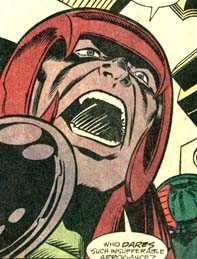
(Historical) - The center of Seth's cult of worship was the city Ombos in the Upper Kingdom, where Seth enjoyed greater influence than in the lands further downriver. The worship of Seth often fell on hard times but always experienced periods of intense revival, never remaining in the background permanently or for long. One such period of intense revival was circa 1675 BC during the Hyksos domination. Perhaps with Seth's aid the hekaukhasut, "the rulers of foreign lands", conquered the ancient Egyptians (before they had mastered either the horse or the chariot which likely helped the mounted Hyksos more than Seth). The foreign conquerors were avid worshippers of the aggressive god, building many temples to him and likening him to their own storm-god Baal. The Hyksos capitol during their reign in Egypt was Avaris, another older center of Seth worship. While the Hyksos dominated the Nile Delta, they attempted to wipe out the worship of all other gods and impose Seth as the supreme deity of all Egypt.
Ultimately, the Hyksos
were overthrown and defeated by the
Egyptians led by the Theban royal family. This victory was
possibly achieved
with the help of Khonshu in the guise of another moon-god, Yah, in
whose
honor many of the royal family were named (Yahmose - "Yah is born",
Yah-hotep,
Yahmose-Nefertari, etc).
(Incredible Hulk I#257 (fb) - BTS) - Seth created two demons, Gog and Magog, which were imprisoned by an Egyptian Pharaoh (who may have been Yahmose or Kamose).
(Marvel Tales#96/3) - Seth created for himself the Sphinx, a female demon who was his most devoted servant, and intended for her to survive long after his own death to continue to spread evil.
(Thor I#240-241 (fb), The Official Handbook of the Marvel Universe Update '89#7) - Seth defeated Horus after centuries of struggle. The decisive victory for Seth took place simultaneously with the sea battle at Actium, in which the Roman forces of Octavius Caesar defeated the navies of Cleopatra and Mark Anthony, circa 30 BC. Replacing Osiris as god of the dead (who went on to succeed Ammon-Ra as King Of The Gods), Seth imprisoned the Egyptian gods in a pyramid and later conquered Celestial Heliopolis, the realm of the gods of Egypt.
(Journey into Mystery I#-1 - BTS) - In recent times, while fleeing from a union of Loki and several Frost Giants, Balder and Sif discovered thousands of rats gnawing upon the root of Yggdrasil, the World Ash. The rats had been summoned to do so by Seth, and they were guarded by one of Seth's Demons of Death. This warrior was powerful enough to gravely injure Sif, although she ultimately vanquished him. The warrior chose to incinerate himself rather than reveal his master's name to Sif. Balder drove off the rats, although he predicted it would take centuries for Yggdrasil to fully heal itself.
(Captain America I#166-167 - BTS) - Seth was invoked by the Yellow Claw in order to place the spirit of the Egyptian princess Fan-Le-Tamen into the body of his niece Suwan. When Fan-Le-Tamen turned against him, the Yellow Claw invoked Seth again to have her spirit enter him.
(Thor I#240-241) - In recent years, the pyramid appeared in the United States and the Asgardian gods Thor and Odin appeared to free the gods trapped in it. Seth appeared with his Army of the Unliving to try and stop them, but Odin defeated him by severing Seth's hand with a bolt of energy. Freed from the pyramid, Horus cast his uncle from the Golden Bridge into Heliopolis.
(Marvel Two-In-One #22-23) - Seth attempted to reclaim Heliopolis by sacrificing Horus to a monster called the Devourer, but the entity went on a rampage and he had to release his nephew to help fight the creature. Thor and the Thing appeared to assist in destroying the Devourer and Seth was ousted once more.
(Thor Annual#10) - Seth and Pluto of Hades began plotting with Mephisto to expand their realms by uniting them. Enlisting Ahpuch, Eriskegal, Hela and Yama into the plot, they began merging their respective realms but, instead, released Demogorge from the dawn of time who began consuming all of them. The primeval entity went on to consume Thor and the warrior-gods coming to the rescue, but Thor caused a shift in the creature's palate which reversed Demogorge back into Atum, released all those consumed, in turn. Seth and the others abandoned their plans over the humiliation of their experience.
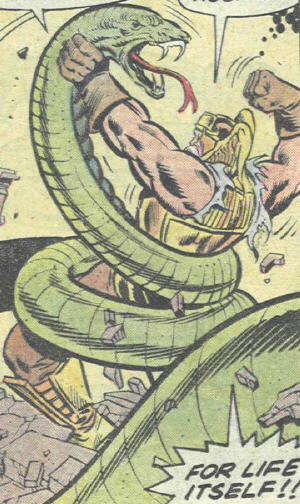
(Thor I#386, [387, 388], 390-399, West Coast Avengers II#41) - Seth once more conquered Heliopolis, but to hold his position he absorbed the life-forces of the Ennead and imprisoned Bes for his good luck in order to lay siege to Asgard. He took Odin out of his battle with Surtur, making him his prisoner, in turn; he made Grog his second-in-command; finally, he transformed three mortals into powerful allies known as Earth Force. Seth, however, was opposed not only by Balder, Sif, Tyr, and the other Asgardians, but also by Asgard's trolls, dwarves, and Frost giants, as well as the Asgardian's former enemies, The Celtic Gods, and even his empowered creations, Earth-Force.
(Thor I#400) - Seth easily dispatched Earth Force, but they slowed him down just enough. Grog the God-Slayer seemingly perished, taking the Ultimate Obliterator with him, when Surtur flung the Black Pyramid at Thor. But Surtur had arrived too late, after the thunder god had freed Odin, who then fought Seth as he transformed into a huge serpent. His skull pierced by the Black Knight's Ebony Blade-like body hurled by Hogun the Grim, Seth weakened and shrank out of sight. With his defeat, Asgard and Heliopolis returned to normal. The Heliopolitan Gods resurrected Earth Force and sent them back to Earth, still bearing the mark of their powers, the Sign of Aton.
(Thunderstrike#13-14 - BTS) - From the shadows of his Armageddon Complex, Seth, now wearing a bio-engineered reptilian body, directed his operatives Mongoose, Quicksand, and Bison in an attempt to steal Inferno-42 from SHIELD before they could dispose of it. The attempt failed, thanks to Thunderstrike, Luke Cage, and the defection of Bison.
(Thunderstrike#17-18) - The vigilante Bloodaxe tracked Seth to his base and fought him. Not possessing enough power to defeat him, Bloodaxe returned with Thunderstrike and Stellaris, the Celestial Slayer. In the course of their battle, Seth placed his brand on Thunderstrike.
(Thunderstrike#19-20) - Their battle was ended when one of Thunderstrike's attacks shattered the Armageddon Complex, allowing water to spill in; Seth departed and later met up with Loki, who was, at that time, an astral body. Loki enlisted Seth to aid him in gaining a new physical form.
(Thunderstrike#21) - Seth made good on his deal with Loki, and bio-engineered a new physical body for him, identical to his original.
(Thunderstrike#23) - Seth was finally tracked down by Thunderstrike, now empowered with all of Bloodaxe's abilities; Seth attempted to sway Thunderstrike to his side, but it proved unsuccessful; with his powers vastly increased, Thunderstrike was able to destroy Seth.
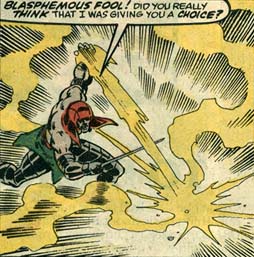 BTS - Seth got better.
BTS - Seth got better.
(Thor I#494 - BTS) - Seth directed a human minion, Price, in an attempt to destroy Yggdrasil, the Asgardian World-Tree. Odin took advantage of this action to try and prevent Ragnarok from occurring, by making Yggdrasil believe it had already occurred, casting the Asgardians into mortal forms.
(Journey Into Mystery I#503-504 - BTS) - Seth dispatched his minions, the Men in Black, to prevent the Asgardians from regaining knowledge of their true identities. While the Men in Black were successful in slaying the Thor-substitute Red Norvell, the other "Lost Gods" slowly regained their memories.
(Journey Into Mystery I#505) - Seth's lab within Yggdrasil was accidently found by the Wrecker. Seth beat him savagely to prevent anyone else from finding the lab.
(Journey Into Mystery I#506-507) - Several of the Lost Gods confronted Seth in the laboratories where Yggdrasil was being controlled. Seth nearly killed Freddie Moyer (Fandral the Dashing), but his comrades saved him with the Golden Apples of Idunn.
(Journey Into Mystery I#508-509) - With Odin in his clutches, Seth resurrected Red Norvell and Lorelei to capture the other "Lost Gods". When Loki reverted to his original form, with his memories intact, he switched sides, joining with Seth.
(Journey Into Mystery I#510-511) - When Loki proved to be fooling Seth, the two of them fell into combat, and Seth transformed Loki into wood, to keep him from interfering with his plan.
(Journey Into Mystery I#512-513) - Seth sent Red Norvell to restore the Asgardians to their true forms so that when he destroyed Yggdrasil, it would recognize and destroy them all. However, once restored to their normal forms, the Asgardians, rallied by Odin, were able to defeat Seth, and dismantle his machinery.
BTS - Seth apparently telepathically contacted Morpheus and Black Spectre, foes of Moon Knight, recruiting them for his future plans.
(Moon Knight IV#1) -
Marc Spector (former alter ego of the
superhero Moon Knight/former avatar of the god Khonshu), in the
afterlife, was confronted
by Khonshu, who informed him of the return of Seth. According to
Khonshu, "The ancient war is
now renewed, and your are needed to do battle with this dark
force." Indeed,
around this time, after weeks of digging, archaeologist Simon Darkover
unearthed
the tomb of Pharaoh Seti III. He found a statue of Seth, here
called Set (See
Comments). Darkover thought he saw the statue move but
dismissed it
as a bit of imagination. The statue then grabbed him by the throat and
killed
him.
Meanwhile, Frenchie and
Marlene, Spector's confidants in life, returned to Grant
Mansion, Spector's former haunt. They saw the Khonshu
statue. Apparently unseen by them, Seth said, "Your knight
is dead, Khonshu...and your light, moon god, is eclipsed!" The
statue of
Khonshu started to crack, then blew up. Marc Spector
emerged--alive.
However,
the statue then reappeared, undamaged. Marc Spector resumed his
identity
of Steven Grant.
(Moon Knight IV#2) - In another vision, Khonshu informed Spector of how
Black
Spectre served Seth's plans. Later that day, in the museum holding the
recently
unearthed statue of Seth, Seth animated a mummy and had it kill a
security
guard.
(Moon Knight IV#3) - Khonshu's statue spoke to Spector, saying, "It is
the dark
god of Chaos, and he is free." Indeed, in Egypt, Bushman, under
orders from
Morpheus, stole the statue of Seth. Later, the ghost of Simon
Darkover visited
Spector in a dream but was abducted by Seth.
(Moon Knight IV#4) - Khonshu again appeared to Spector but then Seth
appeared,
attacking Khonshu, in turn.
Spector awoke, realizing that his opponents Morpheus (who received
enhanced
strength from Seth), Bushman, and Black Spectre intended to use the
power
of the statue of Seth to curse diplomats at an upcoming U.N.
conference. Morpheus used his illusion powers to make U.N.
security think the statue
was a gift from the Egyptian president, having them install it in the
general
assembly room, in response. Consequently, Set's magical influence
would implant feelings of rage and
anger amongst all present, ending the peace talks and bringing about
war.
Spector confronted Morpheus in his helicopter before Morpheus could
reach
the U.N. helipad, allowing the statue of Seth came to life.
Spector managed to
push the statue out of the wildly careening helicopter, escaping the
copter
before it crashed.
(Avengers/JLA#4) - Seth was among the villains pulled from time by Krona during the Chronal Chaos event, to use as an army against the Avengers and Justice League. During the battle, he confronted Dr. Fate, who held him back with a spell. When the heroes defeated Krona and succeeded in restoring their respective universes to their normal states, Seth presumably went back to whatever point in time he was plucked.
(Thor Annual II#1 (fb) - BTS) - An oracle of Hem-Net Jer called Seth to Celestial Heliopolis.
(Thor Annual II#1) - The oracle wanted to tell Seth about one of his enemies. Not as Seth suspected Osiris, but Thor. After paying the oracle with gold he informed Seth that Thor had been banished from Asgard for slaying his grandfather Bor and was weakened by it in heart and soul.
Seth summoned his agents Gog, Magog, Grog the God-Slayer and Scarab to tell them about Thor's weakness and send them after Thor. He ordered them to search for Thor individually in the U.S. Interior Highlands where he was last sighted. Whoever found him should call the others so they could defeat Thor together. Staying in contact with his agents while the attacked locals to lure Thor out of hiding he wasn't called as ordered when Grog found Thor. Grog arrogantly fought Thor by himself until he was defeated. Only then did he call the others. Seth teleported in with Gog, Magog and Scarab and watched Gog being taken down quickly by Thor. Scarab realized Thor wasn't broken anymore, but Seth still blocked Mjolnir when Thor hurled it at him. Though he was sure Thor wasn't back to his old self and was still broken he teleported away with his agents and promised he would destroy Thor on the day the oracles determined.
Seth approached the oracle and wasn't pleased when the priest told him that Grog attack altered the future. When the priest demanded more gold to read the future Seth instead gave him Grog's severed arm to show the priest what happened to those that disappointed Seth.
(Fearless Defenders#3 (fb) ) - Hela bargained with the other death gods, including Seth, to resurrect Hippolyta.
SECRET WARS III HAPPENED
(Moon Knight VIII#8) - Seth was held captive by Khonshu in a plot against Moon Knight.
Comments: Seth was adapted for Atlas by Werner Roth, and for Marvel Comics by Roy Thomas, Bill Mantlo (writers) and Sal Buscema (artist).
As pointed out in the powers section, Seth is a god of storms and the desert wastes, yet he has not shown any abilities associated with such areas of influence in the Marvel Universe to date. But this does not necessarily mean that he does not possess such abilities at all. In fact, the demon that fought Arabian Knight in Marvel Comics Presents I#47 could manipulate storms in the desert wastes, and this demon may be one in the same as Seth's Gog and Magog. If this is so, then surely Seth could do what his creations were able to do, and even if he could not Seth can summon creatures that can, granting him the ability to harness storms by proxy. --Kyle
Much of Seth's early history is an adaptation of myth set in a Marvel scenario to explain several idiosyncrasies between the various myths and the Marvel stories. Part of which is the confusion between Horus the nephew and Horus the brother as well as Osiris as ruler of the Egyptian gods over Ammon-Ra who was more of a Egyptian Titan.
--Harpocrates is merely an alternate name for Horus (or another Hours as there were many in Egyptian myth if they were not all manifestations of one Horus). The idea of Seth and Horus as brothers was a later addition to the mythology coming after, not preceding, the myths of Seth as the usurping uncle and Horus as the avenging nephew. Heru-Ur, known as Horus the Elder, might be a more appropriate name for Seth's early rival. On a related note, I still dispute that Annubis is Osiris' son and not Seth's. Annubis, the son of Nephtys, Seth's wife, has been attributed as the son of both deities in various hieroglyphic texts, so a case can be made for both, but given Annubis's more villainous behavior in the Marvel Universe, Seth would seem the more appropriate parent (the son reverting to type after assisting the other gods in thwarting his father's conquests). - - Greg O.
Several death gods known in myth do not join Seth and Pluto in uniting their realms. Of these, Yen-Lo Wang (Chinese), Emma-O (Japanese), Chibiabos (Anasazi) and Hina (Oceanic) might still have worshippers today. Chibiabos, Arawn (Celtic), Tuonetar (Finnish) and Pikuolis (Slavic) would be benevolent deities who turned down participation. Damballah (African) might not be on good terms with Seth as would Vichama (Incan) with Ahpuch. --Tuonetar was of Pohjola, the Land of evil, and likely not beneficent, just uninterested - - Greg O.
Atum (Demogorge) and Atum-Ra are the same deity.
The Further Adventures
of Cyclops and Phoenix#1 had
Apocalypse, in 1859 London, recall his origin in ancient Egypt.
He remembered
his time as a slave and his powers manifesting after a vision of
Seth. Peter
Milligan wrote this story, published in 1996.
However, later that year, a more extensive account of Apocalypse's
origin appeared in the mini-series "The Rise of Apocalypse". In
this mini-series,
the slave origin remained, but Nur had a vision of Isis not Seth.
Click here
for a good summary of the Rise of Apocalypse mini-serie:
http://www.chronology.net/default.pl/cited/rd_cable/7
As to which represents the more accurate version....I prefer the Seth
vision, as that ties things together better. Of course, Seth
could have pretended
to be Isis, too--Per Degaton.
About one year
after Seth's appearances in Journey Into
Mystery came out, Doug Moench returned to Moon Knight in his first
story
with the character--whom he co-created--in six years. He used Set/Seth
for
the plot. However, Seth's presence in the 1998 Moon Knight series
is a bit
strange, as he is referred to as Set throughout, he never appears in
the
costume we saw him in for most of his Thor appearances (he appears
rather
in the image of a statue as seen in the scan below), no mention is made
of
him being connected with serpents, and no mention of his 15+ preceding
appearances against Thor or Thunderstrike occur. Even worse,
Morpheus in
Moon Knight IV#3 states that Set(h), "has lain dormant for millennia,
sleeping
in his tomb." Morpheus apparently did not check with Thor before making
this
statement.
I personally guess that Moench, who clearly expressed in fanzines his distaste for other writers and artists' interpretations of Moon Knight since he left, wanted to ignore as much as possible anything that had occurred since the end of Moench's run on the original Moon Knight series. ("Nobody who wrote Moon Knight after I left understood the character or did a good job; it's as simple as that", as Moench said in an article in Comics Scene#52 in 1995). So, Moench did not bother to research previous writers' adaptations of Set/Seth in the Marvel Universe. (Ironically, Moench also wrote the Conan graphic novel "The Skull of Set"!).
The mini-series has an archaeologist refer to Set/Seth as "slayer of Osiris", so we are dealing with the Pesdjet Seth here. There is nothing outrageously wrong with the 1998 Moon Knight limited series to disbar it from Earth-616 continuity, though it is a little bizarre to think that Seth has already fallen victim to Loose-Continuity-In-Adaptions-of-Mythology-Characters-Syndrome.--Per Degaton
A word on the history of Egypt on Earth-616; by way of the adaptation of the essay the Hyborian Age in Savage Sword of Conan, we know that the early human pharaohs of Egypt were descendants of red-haired Nordic Vanir adventurers who deposed the Stygian ruling class.--Per Degaton
Seth has also received entries in all four versions of the Official Handbook of the Marvel Universe, as well as Marvel Zombies: The Book of Angels, Demons & Other Monstrosities.
In one alternate
timeline, @ What If...? II#38, Seth successfully
conquered Asgard, rather than being defeated as in Thor I#400.
In the alternate future of Earth-MC2, Seth showed up as leader of the
Soldiers
of the Serpent, @ Spider-Girl#54-59.
General Cheops was identified as one of the Demons of Death in West Coast Avengers#41.
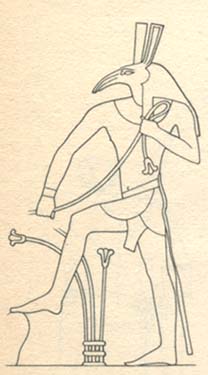
Other assorted notes from Greg O:
Ennead (the group of Heliopolitan gods of which Seth was once a member) is Greek for Nine, representing the nine chief gods of the Egyptian pantheon akin to the twelve supreme gods of the Olympians. This group is called the Pesdjet in the native tongue of Ancient Egypt. Horus was often referred to as the Bull of the Pesdjet.
Seth might not have always been a "serpent-god." Most of the hieroglyphic representations of Seth are either a mythic beast with no known analogous counterpart in the real world or are anthropomorphic, a man with the head of this beast. Additionally, Apocalypse, when he posed as Seth, took on the jackal visaged form of the god, which is more analogous to Seth's Sutekh incarnation. Also, the statue of Set/Seth in the 1998 Moon Knight series is more in line with that version of him. Perhaps Seth abandoned his original heraldic animal in favor of the serpent in order to obtain the more sorcerously proficient Set-worshippers as his followers. An image of Seth's original heraldic beast appeared on King Scorpion's macehead at the end of the pre-Dynastic Era.
In many hieroglyphs Seth is represented as beneficent, a protector of both Re and the pharaoh from the demonic forces waiting in the underworld. Most especially, during the portion of the trip the when the solar barge passes near the demon-serpent Apophis, Seth waits in the bow of the boat to thrust a long spear down the giant snake's throat, ending his threat. In the MU this could be representational of Seth's usurpation of the Elder God Set, identified with Apophis in this case. However for the common Egyptian, if Seth was not properly placated, he was one of the terrors of the underworld to be avoided at all costs, seizing the deceased's soul, consuming putrefaction, and generally lurking in dark and gloomy quarters.
Tuthmosis III of Dynasty XVIII called himself "Beloved of Seth." Pharaoh Setnakht ("Seth is Mighty") was called Khepri-Seth, vanquisher of rebels against royal authority.
by Will Uchtman and Prime Eternal with additional comments/info/images from Greg O, Nick Hill, the Squid, and Snood.
CLARIFICATIONS:
Seth should not be confused with:
The Devourer used by Seth @ MTIO#23 has no known connection to
The Men in Black should not be confused with:
The Demons of Death, are Seth's prime agents, used in several of his campaigns. General Cheops served as one of the Demons of Death. The Demons of Death are typical thugs, dressed in armor, with access to staffs that fire energy blasts, energy-cannon tanks, and other advanced weapons of Heliopolitan warfare. Other Demons of Death, perhaps the main group's branch of assassins, wore only sandals, hooded cowls, and kirtles, employing poisoned blow darts from hiding during Seth's "one-on-one" battle with Balder.
--Thor I#387, 389-390, 393, 395-400, West Coast Avengers II#41, Journey Into Mystery I#-1, 510-513
&nsbp;
The Serpent's Teeth were Seth's human agents during his time on Earth, while operating from the Armageddon Complex. They were equipped with weaponry similar to his Demons of Death, but were mainly garbed in armor, and armed with conventional firearms.
--Thunderstrike
#16-17, 21
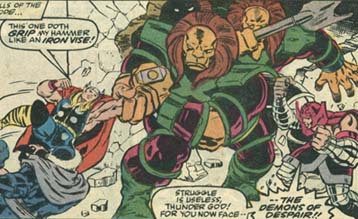
The Demons of Despair were giant monsters sent by Grog to try and prevent the escape of Thor and his allies from the Black Pyramid. Beyond their superhuman size and strength, they had little to offer against the power of Thor.
--Thor I#399
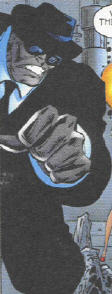
The Men in Black were Seth's agents amongst humanity, sent to kill the Asgardians before they could recall their past lives. They were troll-like and possessed superhuman strength. Their ranks also included an unnamed armored figure, whose suit bore a striking resemblance to Iron Man's.
--Journey Into Mystery I#503-504, 506-507
Appearances:
Marvel Tales I#96 (June, 1950) - Werner Roth (artist), Stan Lee (editor)
Thor
I#240 (October, 1975) - Roy Thomas & Bill Mantlo (writers), Sal
Buscema (pencils), Klaus Janson (inks), Roy Thomas, Marv Wolfman &
Len Wein (editors)
Captain America I#166-167 (October-November, 1973) - Steve Englehart
(writer), Sal Buscema (pencils), Frank McLaughlin (#166) & Frank
Giacoia (#167) (inks), Roy Thomas (editor)
Thor I#241 (November, 1975) - Bill Mantlo (writer), John Buscema (pencils), Joe Sinnott (inks), Marv Wolfman (editor)
Marvel Two-In-One#22-23 (December, 1976 - January, 1977) - Bill Mantlo
& Jim Shooter (#23) (writers), Ron Wilson & Marie Severin (#23)
(pencils), Pablo Marcos (inks), Archie Goodwin (editor)
Incredible Hulk I#257 (March, 1981) - Bill Mantlo (writer), Sal Buscema (artist), Al Milgrom (editor)
Thor Annual#10 (1982) - Mark Gruenwald & Alan Zelenetz (writers),
Bob Hall (pencils), Rick Bryant, Joe Rubinstein, Andy Myshynsky, Al
Grodon & Kevin Dzuban (inks), Mark Gruenwald (editor)
Thor I#386 (December, 1987) - Tom DeFalco (writer), Ron Frenz (pencils), Joe Sinnott (inks), Ralph Macchio (editor)
X-Factor I#24 (January, 1988) - Louise Simonson (writer), Walt Simonson (pencils), Bob Wiacek (inks), Bob Harras (editor)
Thor I#390-393 (April-July, 1988) - Tom DeFalco (writer), Ron Frenz
(pencils), Brett Breeding (#390-391, 393), Al Milgrom (#392) (inks),
Ralph Macchio (editor)
Thor I#394-397 (August-November, 1988) - Tom DeFalco & Roger Stern
(writers), Ron Frenz & Bob Hall (#394, 396) (pencils), Brett
Breeding (#394-395, 397), Tony DeZuniga (#394) & Don Heck
(#396-397) (inks), Ralph Macchio (editor)
Thor I#398 (December, 1988) - Tom DeFalco (writer), Ron Frenz (pencils), Don Heck (inks), Ralph Macchio (editor)
Thor I#399 (January, 1989) - Tom DeFalco (writer), Ron Frenz (pencils), Romeo Tanghal (inks), Ralph Macchio (editor)
West Coast Avengers II#41 (February, 1989) - Tom DeFalco & Ralph
Macchio (writers), Tom Morgan (artist), Howard Mackie (editor)
Thor I#400 (February, 1989) - Tom DeFalco (writer), Ron Frenz (pencils), Joe Sinnott (inks), Ralph Macchio (editor)
Punisher Annual#2 (August, 1989) - Peter Sanderson (writer), Mark Bagley (pencils), The Dudes (inks), Mark Gruenwald (editor)
Further Adventures of Cyclops and Phoenix#1 (June, 1996) - Peter
Milligan (writer), John Paul Leon (pencils), Klaus Janson (inks), Mark
Powers (editor)
Thunderstrike#13-14 (October-November, 1994) - Tom DeFalco & Ron
Frenz (writers), Ron Frenz (pencils), Al Milgrom (inks), Ralph Macchio
(editor)
Thunderstrike#17-21 (February-June, 1995) - Tom DeFalco & Ron Frenz
(writers), Ron Frenz (pencils), Al Milgrom (inks), Ralph Macchio
(editor)
Thunderstrike#23 (August, 1995) - Tom DeFalco & Ron Frenz
(writers), Ron Frenz (pencils), Al Milgrom (inks), Ralph Macchio
(editor)
Thor I#494 (January, 1996) - Warren Ellis (writer), Mike Deodato Jr. (artist), Ralph Macchio (editor)
Journey Into Mystery I#503-504 (November-December, 1996) - Tom DeFalco
(writer), Deodato Studios, Carlos Moto (#503) & Rene Micheletti
(#503) (artists), Mark Gruenwald (editor)
Journey Into Mystery I#505 (January, 1997) - Tom DeFalco (writer),
Deodato Studios (artists), Mark Gruenwald & Terry Kavanagh (editor)
Journey Into Mystery I#506-507 (February, 1997) - Tom DeFalco (writer),
Deodato Studios, Carlot Mota, Eddie Wagner & Rene Micheletti
(artists), Terry Kavanagh (editor)
Journey Into Mystery I#507 (March, 1997) - Tom DeFalco (writer), Mark Campos (artist), Bobbie Chase (editor)
Journey Into Mystery I#508-510 (April-June, 1997) - Tom DeFalco (writer), Deodato Studios (artists), Bobbie Chase (editor)
Journey into Mystery#-1 (July, 1997) - Tom DeFalco (writer), Deodato Studios (artists)
Journey Into Mystery I#511 (August, 1997) - Tom DeFalco (writer), Deodato Stuiods (artists), Joe Andreani (editor)
Journey Into Mystery I#512-513 (September-October, 1997) - Tom DeFalco
(writer), Sal Buscema (pencils), Al Milgrom (inks), Joe Andreani
(editor)
Moon Knight IV#1-4 (January-April, 1998) - Doug Moench (writer), Tommy
Lee Edwards & John Paul Leon (#4) (pencils), Robert Campanella
(inks)
Avengers/JLA#4 (February, 2004) - Kurt Busiek (writer), George Perez (artist), Tom Brevoort & Dan Raspler (editors)
Thor Annual#1 (November, 2009) - Peter Milligan (writer), Mico Suayan
& Tom Grindberg with Stefano Gaudiano (artists), Warren Simons
(editor)
Fearless Defenders#3 (June, 2013) - Cullen Bunn (writer), Will Sliney (artist), Ellie Pyle (editor)
Moon Knight VIII#5 (October, 2016) - Jeff Lemire (writer), Greg
Smallwood, Wilfredo Torres, Francesco Francavilla, James Stokoe
(artists), Jake Thomas (editor)
First Posted: 09/10/2002
Last updated: 07/10/2017
Any Additions/Corrections? please let me know.
All characters
mentioned or pictured are ™ and © 1941-2099
Marvel Characters, Inc. All Rights Reserved. If you like this stuff,
you
should check out the real thing!
Please visit The Marvel Official Site at:
http://www.marvel.com
Special Thanks to www.g-mart.com for hosting the Appendix, Master List, etc.!